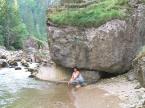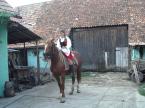Information
Beiuş (Hungarian: Belényes) is a city in Bihor County, Romania near the Apuseni Mountains. The river Crişul Negru flows in Beiuş.
History
It has first being attested documentary in the year 1263, mentioned as being burned down during a Mongol invasion in 1241. Later, between late 18th and very early 20th century the city of Beiuş constituted one of the most important learning centers in Romanian language of Transylvania, during Austro-Hungarian Empire reign, when Romanians had little or no benefit of political rights and their representation was very poor, including in religion.
Time line
- Estate of the Oradea Bishopric is mentioned for the first time in the Regestrum Varadiensis. It was mentioned under Benenus in 1291, Belinis in 1300 and Benenes in 1309.
- 1451 free royal city under John Vitez of Zredna.
- Seal of Beiuş showing Ladislaus I of Hungary inscribed around: "Sigillum Oppidi Belenes"
- 1552 Oradea Bishopric tithe list counts more than 420 settlement house.
- 1570 Under Speyer Agreement, Prince of Transylvania ruled this region.
- 1660 The Ottoman Empire conquested Beiuş.
- 1691 The Austro Hungarian Empire conquered Beiuş.
- 1692 A census mentions 9 Hungarians families.
- 1715 A census mentions 29 Hungarians families.
- 1720 52 Hungarians family and 22 Romanian family lived in the city.
- 1754 A romanian secondary school opens, the second in Transylvania after the one at Blaj.
- 1777 Maria Theresa of Austria founded Greek Catholic Bishopric with the residence in Oradea and endowed the Bishopric with an estate at Beiuş.
- Bishop Samuil Vulcan (1806-1893) built up a Greek Catholic Church, set up the Greek-Catholic secondary school in Beiuş and endowed it with everything necessary.
- 1850 1250 Romanian and 950 Hungarians family lived in the city.
- 1914 2134 Hungarians and 1974 Romanian lived in Beiuş.
- 2002 Around 1,000 Romanians and around 1000 Hungarians live in Beiuş.
Places to see
Nevertheless, today, a peaceful place combining few ethnies and three times a much religions has superb architectural edificies like few old churches and the 1828 built "Liceul Samuil Vulcan" high school ranking after year 2000 also as "National College". The city is a keypoint in reaching the Apuseni Mountains and their rich mines, or mountain resorts like Stâna de Vale or Arieşeni trough smaller but picturesque communities and villages like Budureasa or Vascau. The nearby mountains are hosts to some of the most dense and spectacular limestone cave systems in the world home to the extinct cave bear (Ursus speleus) or prehistoric men bone vestiges, huge colonies of bats, subteranean lakes, unbelievable calcarous formations or simply giant earthworms that live in the guano flooded cave floor.Expectedly so according to its rich heritage and long history, Beius has its own museum, a place with exhibits of natural history, military history, art but mostly famous for it folkloric artifacts: peasant tools, pottery, garments or art gathered from entire central and southern county of Bihor. Famous are also the misterious links of underground tunnels believed to link as escape routes during the Medieval Age, eventualy initiated during times of Hungarian king Bela IV. Nearby landscape include agricultural hills with crops ranging from corn, wheat and potato to orchards of fruits like apple, pears, prunes and strawberies. A long stretch of wildlife depleted forest but rich in flora stretches from northeast of the city. Industry is represented mainly trough production of furniture and fashion destined for the European market. Nearby gigantic distilery and refreshing beverages plant of Sudrigiu employes also a hefty part of the city's labour hand.
Available or popular sports in or around Beiuş are: fresh water fishing (trout, catfish, carp and at least a dozen other edible kinds), speleology (spelunking), soccer (Sunday soccer is a local ritual for all ages), ski, snowboard, sleding, tennis, hiking, camping, backpacking and rock climbing. Hunting is also popular for species like: wild boar, roe deer, rabbit, pheasant, partridge or ducks (mainly mallards).

 English
English









